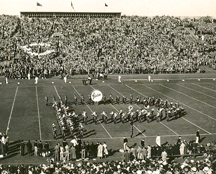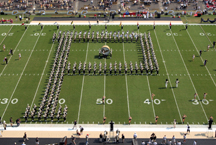
| RELATED NEWS RELEASE |
| * Purdue Band to create giant Block P for Homecoming |

October 23, 2007
Purdue 'All-American' Band's historic Block P turns 100
WEST LAFAYETTE, Ind. - |
A tradition that ties all band members together, the formation is a photo opportunity at weddings, often with two newly wedded band alums encircled inside the P. It's also a tradition that turns 100 years old this fall.
 |
Legend, substantiated by a 1953 article in the Lafayette Journal & Courier, has it that Paul Spotts Emrick, who was named the band's first director (1905–1954) while a sophomore at Purdue, saw a flock of geese flying in a V formation. Known to everyone as Spotts, the young man figured that if birds could form a letter in the air, then certainly his fellow college students could form a letter on the football field. The initial Block P, formed when the band "broke military ranks" on the field in 1907, is believed to be the nation's first.
Evolution of the famous formation
The University of Illinois makes a similar claim, but Al Wright, a professor emeritus who replaced Spotts after his near half-century run as band director, recalls evidence to the contrary.
"I came to campus on July 1, 1954, after only meeting Spotts once," says Wright, who served as director from 1954 to 1981. "I was going through Spotts' files and found a letter from the Illinois president's office asking if he had charts on how to make the formation."
While claims of who came first may be lost history, there's no doubt that Purdue's Block P became a forerunner for standard band practices that continue nationwide today.
West Lafayette's Roy Johnson has been a longtime witness to the famous formation. He joined the band as a freshman in the fall of 1956, played clarinet, and has been involved ever since. Today he serves as the band announcer and adviser to Kappa Kappa Psi, the band's honorary fraternity.
"There have been various formats through the years," Johnson says. "Spotts used to use a rounded P. Al Wright tended to square off the P with the use of yard lines. In recent years the band has slanted the letter halfway through the chorus to reflect the action P the athletic department adopted."
Wright says Spotts had a 120-piece band, forming a doubled-line P. "The guys all turned right and marched clockwise," he says, "gyrating it like lights on a movie marquee."
As Wright's band grew to 280 members, he utilized three lines and kept the middle line still. In the 1980s, as the band grew even larger, they formed two Ps on the field, one for fans on each side of the stadium.
Honoring long-time traditions
Both Spotts and Wright, who accounted for nearly 80 years of the band's leadership, seemed to look for hooks for their squads. Spotts came up with the idea for the "World's Largest Bass Drum," and Wright officially added the nickname "All-American" to the band. He also came up with the "I Am An American" poem read before each home game.
"That's interesting," Wright says with a laugh, "because I'm a Brit."
But the hooks remained.
"The terrific thing about Purdue bands is the tradition," says Jay Gephart, who became the director in 2006. "That's what really means the most to me. There are some bands all around the country who have really given up some of the long-lasting traditions to go in the direction of a more contemporary marching band. The beauty of Purdue, and quite frankly a lot of the groups in the Big Ten, is we have held onto these valuable traditions."
To celebrate the 100-year anniversary of the Block P this year, Gephart says the band will go back to the original formation. "We owe a debt of gratitude to Spotts for being a visionary," he says.
Gephart's sentiment is shared by many associated with the band.
"I would have loved to have met Spotts personally," says Kathy Matter, the band's director of public relations, making special note of his creativity and courage. "It had to take some guts to dare to be different. If everyone is doing things one way, most people won't break out of that mold."
Ironic then, perhaps, that the young man who found inspiration in the V-flying geese created an easily formed formation known to thousands of Purdue band members over the last 100 years. A mold, if you will, to be imitated by a million or more band marchers worldwide.Writer: William Meiners, (765) 496-6524, wmeiners@purdue.edu
Purdue News Service: (765) 494-2096; purduenews@purdue.edu
To the News Service home page
If you have trouble accessing this page because of a disability, please contact Purdue News Service at purduenews@purdue.edu.
